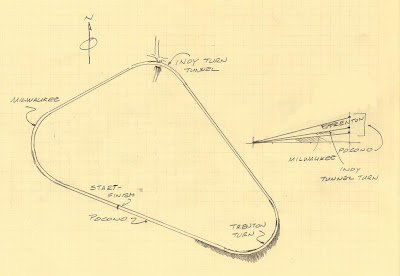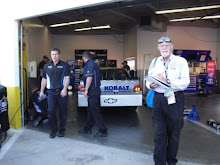The mind bender track for crew chiefs and racecar engineers
Stroll back in history to 1971, when suddenly one day a successful, busy, wealthy Philadelphia dentist decided he’d had enough of the daily grind—seven days a week for eight years—he just packed it all in and went on holiday. The Pocono Mountains were the east coast getaway place; Dr Mattioli bought into some property for its land value and somewhat to his chagrin found himself also in the race track business. Long Pond, Pennsylvania, a little village less than 75 miles from Times Square in New York City, and less than 100 miles from Constitution Hall in downtown Philadelphia, it was a perfect market to attract the big city crowds.
What must have seemed like an incredibly clever idea: pattern your new race track after the most famous tracks in the country. Trenton Speedway, in Trenton, New Jersey, then the premier track on the east coast; the Indy 500; and the Milwaukee Mile, then the most famous track in the Midwest (less than 100 miles from Chicago). Use only proven designs and you don’t have to pay an architect to in an attempt to create something better than what was already considered the best race tracks in the world.
The Mind Bending Pocono Pretzel
The Mind Bending Pocono Pretzel
 Dover has Miles the Monster, Atlanta and Lowe’s have Lug Nut, Pocono needs the Pretzel, mind twistingly difficult to set-up a car for all three turns.
Dover has Miles the Monster, Atlanta and Lowe’s have Lug Nut, Pocono needs the Pretzel, mind twistingly difficult to set-up a car for all three turns.Opened for racing in 1974 the Pocono Speedway is unique in that it has three distinct turns, each one duplicating a turn of the most famous tracks of the day, and the track is huge: 2.5 miles for one lap, same as the distance around the Indy 500 track.
 Turn 1 is the Trenton turn, 14 degree banking, radius is 500 feet a virtual copy of what was really an unusual track. The Trenton Speedway built on the grounds of the New Jersey State Fair property started automobile racing in 1900.
Turn 1 is the Trenton turn, 14 degree banking, radius is 500 feet a virtual copy of what was really an unusual track. The Trenton Speedway built on the grounds of the New Jersey State Fair property started automobile racing in 1900. Trenton was a mile and a half course considered to be a 5 turn track, a kidney shape with a right hand turn in the middle of the back straight-away.
 After eight decades of motorsports, the Trenton Speedway closed in 1980, and the New Jersey State Fair Grounds became the sculpture garden of an art gallery.
After eight decades of motorsports, the Trenton Speedway closed in 1980, and the New Jersey State Fair Grounds became the sculpture garden of an art gallery.A drawing shows the comparison of Pocono, Trenton and Darlington.
 Once around Pocono Turn 1 (the Trenton Turn) the cars race down the Long Pond straight-away (named for the stream that parallels the track) and into Turn 2, now usually called the Tunnel Turn, but its real name is the Indy turn. Again an accurate duplicate of a turn at a famous track, this one is Indianapolis. It’s a full left hand, 90 degree turn on a radius of 860 feet, with 9 degree banking in the corner, a carbon copy of the Indy track.
Once around Pocono Turn 1 (the Trenton Turn) the cars race down the Long Pond straight-away (named for the stream that parallels the track) and into Turn 2, now usually called the Tunnel Turn, but its real name is the Indy turn. Again an accurate duplicate of a turn at a famous track, this one is Indianapolis. It’s a full left hand, 90 degree turn on a radius of 860 feet, with 9 degree banking in the corner, a carbon copy of the Indy track.Then the cars race down a “short chute” (just like Indy) before entering the next turn, but this one is a corner from the Milwaukee Mile.
Racing started in Milwaukee on what was a one mile dirt oval in 1903, with races every year until 1953 when it was paved. Racing has been uninterrupted, now on a paved Milwaukee Mile making it the oldest continuously operated race track in the world; hosting races for every major racing series for more than a century. The winners at the Milwaukee Mile is a list of the most famous in the world from the ancients such as Barney Oldfield, Ralph DePalma, to A.J. Foyt, Mario Andretti, Bobby Rahal, Jim Clark, Alan Kulwicki and now Jeff Gordon, Dale Jarrett, as well as Dale Earnhardt, Jr.
After the Pocono Turn 3 (the Milwaukee Mile turn) the NASCAR Sprint Cup cars run down the front straight, 3780 feet, nearly three-quarters of a mile in length. Until very recently stock cars shifted gears on the front straight because it was so long and the engines would reach such high RPM’s that without shifting the engines would expire long before the 500 miles did. Now, better engine technology and NASCAR rules about gear ratios have eliminated the gear shift.
Racing started in Milwaukee on what was a one mile dirt oval in 1903, with races every year until 1953 when it was paved. Racing has been uninterrupted, now on a paved Milwaukee Mile making it the oldest continuously operated race track in the world; hosting races for every major racing series for more than a century. The winners at the Milwaukee Mile is a list of the most famous in the world from the ancients such as Barney Oldfield, Ralph DePalma, to A.J. Foyt, Mario Andretti, Bobby Rahal, Jim Clark, Alan Kulwicki and now Jeff Gordon, Dale Jarrett, as well as Dale Earnhardt, Jr.
After the Pocono Turn 3 (the Milwaukee Mile turn) the NASCAR Sprint Cup cars run down the front straight, 3780 feet, nearly three-quarters of a mile in length. Until very recently stock cars shifted gears on the front straight because it was so long and the engines would reach such high RPM’s that without shifting the engines would expire long before the 500 miles did. Now, better engine technology and NASCAR rules about gear ratios have eliminated the gear shift.
When racecars did shift gears many drivers called Pocono a “roval,” a cross between a road course and an oval, or a three turn road course connected by very long straights.
TV commentators make a great puffery about Darlington because the two ends of the track are somewhat different compared to all other ovals which are at least intended to be symmetrical. But the difference from one end to the other at Darlington pales in comparison to the differences in the three turns of the Pocono Speedway.
There are two critical elements to a turn, the radius of the corner and its banking, the illustration below shows those parameters for a few tracks.
TV commentators make a great puffery about Darlington because the two ends of the track are somewhat different compared to all other ovals which are at least intended to be symmetrical. But the difference from one end to the other at Darlington pales in comparison to the differences in the three turns of the Pocono Speedway.
There are two critical elements to a turn, the radius of the corner and its banking, the illustration below shows those parameters for a few tracks.
 Notice that the Darlington parameters for the two ends of the track are relatively close together and not all that far off those of Atlanta (which is also similar to Charlotte, and Texas). But the Pocono turns are WAY OFF, and each corner is vastly different from the others. It is simply impossible to find an ideal set-up for all three Pocono turns because they are from three completely different tracks.
Notice that the Darlington parameters for the two ends of the track are relatively close together and not all that far off those of Atlanta (which is also similar to Charlotte, and Texas). But the Pocono turns are WAY OFF, and each corner is vastly different from the others. It is simply impossible to find an ideal set-up for all three Pocono turns because they are from three completely different tracks. But instead of mind bending the crew chiefs to set up just one common NASCAR Sprint Cup car to run all three turns, what if you could bring a car that was designed along the lines of the Pocono track concept; three different kinds of race cars bolted together to make a single vehicle.
What would that look like?
We invite you to send us your version for solving this puzzle; and enjoy the race at Pocono.
We invite you to send us your version for solving this puzzle; and enjoy the race at Pocono.






I am back again - This is a great post. I love your drawings. Especially love your overlay of the other tracks on top of Pocono's map, as well as that matrix where you show how far apart the 3 Pocono turns are compared to each other, and compared to Darlington.
ReplyDeleteAlso, I think the Carl Long drawings and math are very educational.
36 races,
ReplyDeleteThank you for the comment; I didn't realize how dramaticaly different the Pocono turns were until I did the calculations.
Glad you're enjoying the posts.
thanks again,
Prof pi
Well prof, looks like I have some homework to do! I'm going to need to do some sketching myself (and watch the race this afternoon) to wrap my mind around your challenge question. These new race cars are very difficult to turn due to their weight and lack of downforce, so I'm going to be considering a setup involving springs, lower control arm, toe angle, and tire construction. I'll be back to let you know what I've come up with! :-)
ReplyDelete